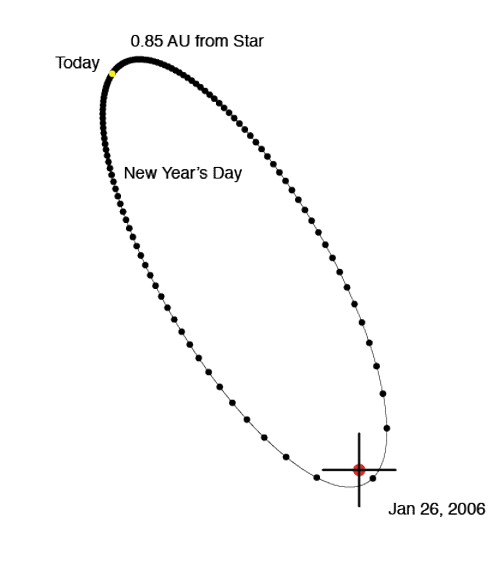Of all the known extrasolar planets, HD 80606b — in both the technical and the colloquial sense — is the most eccentric. This world has at least five times the mass of Jupiter, and it circles its parent star on an extremely elongated 111.4 day orbit:

Today (as seen from Earth!) HD 80606b is still near the far point of its orbit, at a distance of about 0.85 AU from the central star. The temperature in the upper atmospheric layers of the night-side has possibly dipped low enough so that torrential rains and violent thunderstorms are rumbling across its vast billowing horizons. During the rest of December and through most of January, the planet will fall in almost the full distance to the star, eventually swooping within 6 stellar radii as it whips through periastron. On January 26th, at the moment of closest approach, the temperature at the cloud tops will exceed 1000 Kelvin. The auroral displays will be dramatic beyond compare, and indeed, during the days to either side of periastron passage, it might be worth tuning in to the planet on the decameter band.
The discovery of the planet and its orbital solution were announced by the Geneva Observatory Planet Search Team in an April 04, 2001 ESO press release, and the radial velocities have since been made publicly available (right on!) at the CDS repository (see Naef et al 2001). You can therefore use the systemic console to fit this system and examine how radial velocity curves behave for extremely eccentric orbits.
The star HD 80606 is accompanied by a visual binary companion, HD 80607. The projected separation of the two stars is 2000 AU (fifty times the Sun-Pluto distance). When the HD 80606 b travels through the segment of its orbit that lies between the two stars, the night-side cloud tops of the planet are lit by the distant binary companion to ambient brightness that is very similar to a fully moonlit night on Earth. The two stars have similar masses, sizes, and temperatures to the Sun, but, like many of hosts of short-period massive planets, they are enriched in “metals” (gold, chromium, iron, carbon, oxygen, etc. etc.) by a factor of more than two relative to the solar value.
How did the planet get into its weird orbit?
Wu and Murray (2003) have suggested that HD 80606b’s extreme eccentricity is the result of a three-body interaction known as the “Kozai effect” between the planet and the two stars.

Pingback: systemic - orbital
Pingback: systemic - Update from the DC Planet Search
Pingback: systemic - Dexter
Pingback: systemic - pseudo-synchronization